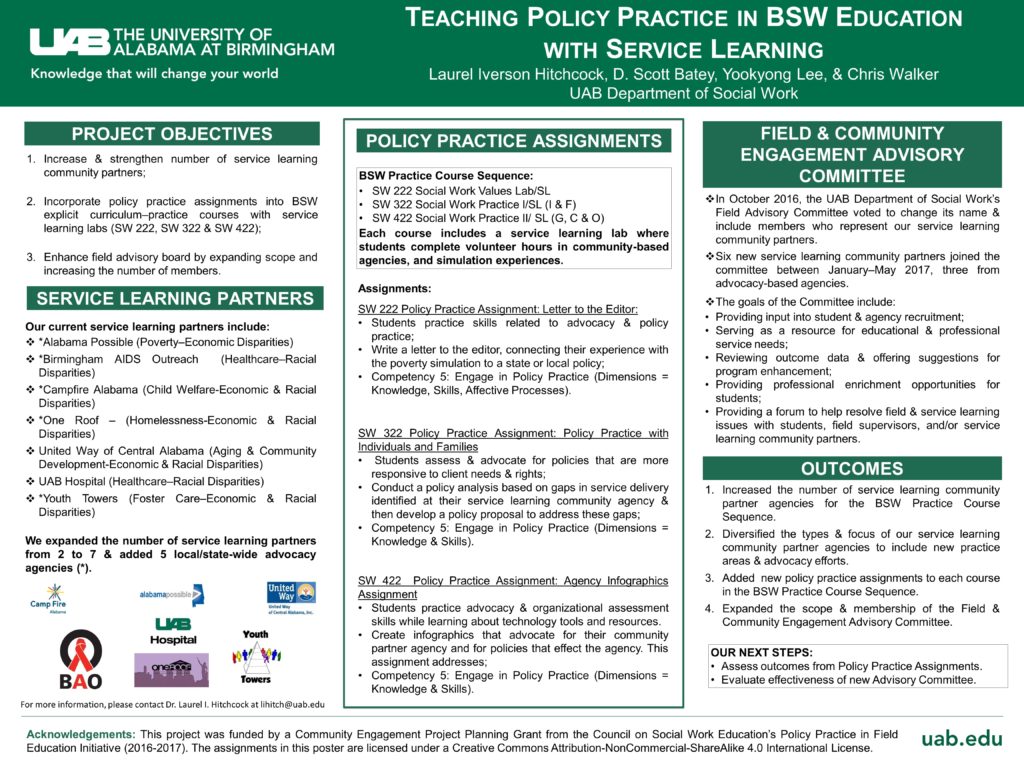#APM17 Day 1 – Infusing Policy Practice into BSW Service Learning Courses
As part of the Field Education Institute, I am presenting a poster with my colleagues Scott Batey, Yookyong Lee, and Chris Walker (University of Alabama at Birmingham) about the work we did for our Policy Practice in Field Education Initiative Grant from the Council on Social Work Education.
Our project involved creating more policy-based learning opportunities into our undergraduate service learning courses, creating a series of policy-focused activities that are grounded in community-based settings. Our curriculum includes three practice courses with a one-hour service-learning lab. Students take the courses sequentially and complete 32 hours in service learning at a community-based agency or simulation for each lab. By integrating policy-focused learning activities into these service-learning labs, we hope to bridge the gap between our policy courses and field education while simultaneously providing all of our students the opportunity to see how policy affects communities and agencies in our state, especially related to issues of economic and racial disparities. Our specific objectives for this planning grant included: 1) Incorporate at least one policy-based assignment or learning opportunity into each of the service learning labs in our practice sequence; 2) increase and strengthen the number of service learning community partners with local and state-wide advocacy agencies focused on addressing issues of economic and racial disparities; and 3) Enhance our field advisory board by increasing membership to include community partners from our service learning projects, especially partners from policy-based agencies.
Here is a copy of our poster:
The Flipped Classroom: Harnessing technology to teach clinical skills to MSW students
Dr. Elisabeth Counselman-Carpenter, PhD, LCSW is a lecturer in social work at Columbia University and maintains a private practice where she works with children and families. In this blog post, she talks about the reasons why she flipped her course on clinical practice with children & families and the practical steps she took to achieve the flip. If you have questions for Elisabeth, you can tweet her at @ElisabethAnneCC .
This course was designed as first semester, second year elective called “Advanced Clinical Practice with Children and Families”. Built on previous content from other courses about life span model and ecosystems perspective, students are expected to leave this advanced clinical course understanding the context and application of evidence-based social work practice with vulnerable populations.
After teaching the course for a year using traditional lecture format, I surveyed students regarding their learning preferences as well as goals and objectives for the semester. Some of the questions I asked included:
– What are your personal goals and expectations from this class for the next 14 weeks?
– What would strengthen your experience in this class?
– What have been some of your key take-aways from other practice classes?
Feedback indicated that students were most interested in focusing on play therapy and other forms of evidenced-based practice with skills be directly taught in class (i.e. modeled and then time for practice in the classroom). Uniformly, students reported that they felt unskilled in putting into place any form of direct practice with children because they only had a surface grasp of “how” to use certain skills with children. All students requested that the course focus on direct application, with a ‘walk-through’ of the skills and interventions, by the professor, covered in the course readings and lectures. Additionally, students felt unsure about where to gather accurate information on how to implement their skills, and reported they were not often given time in field to observe and practice these skills with other staff members. They requested digital case examples, such as training videos, in addition to single case study research articles to enhance their knowledge. This course had rich material in the texts, but students struggled with the “how to” and were bored by simply reading about the techniques.
Using Technology for Productivity: Managing the Academic Workload
This post was written and edited by Nancy J. Smyth, Melanie Sage, and myself as part of our collaboration on our forthcoming book, Teaching Social Work with Digital Technology, to be published by CSWE Press in 2018.
Today’s academic work environments are fast-paced and rely on digital technologies to handle the flow of communication and information such as email, digital calendars, and electronic to-do lists. In this blog post, we asked social work educators and practitioners to share their best tips for using technology as a tool for productivity.
Managing email can be a difficult and time-consuming task. Andy Berkhout, the Data Quality Coordinator from the St. Patrick Center in St. Louis, MO shares his guidelines for managing email:
Clients and colleagues will notice if you are paying more attention to checking email on your phone than you are to them. Instead, set a dedicated time at the beginning or end of the workday to catch up on electronic communication. When it is time to pay attention to the person in front of you, do just that; put your phone away and give your complete focus. Your text messages and email will be still be there later, but the chance to connect with a client or provide meaningful input during a meeting might pass if you’re not giving the present moment your full attention (A. Berkhout, personal communication, September 6, 2017).
Shelly Richardson, an Assistant Professor and Director of Undergraduate Social Work at The College of St. Scholastica in Duluth, MN, uses her prior practice experience to cope with her email:
In my role as an associate professor and director of an undergraduate program, I only check emails twice a day and spend no more than 45 minutes doing so. This forces me to prioritize activities and responses quickly. I only “touch” things once. If I need to take care of something or respond, I do it immediately upon receiving the request. I also have files with names of my frequent contacts (such as co-workers, dean, chair) emails that are initiated by those individuals are easier to find. I also use folder titles for activities I am responsible for (advising, to be graded, coordinating, and committees). These folders allow me to clean up my inbox as I read through emails, I flag emails that are in progress or I need to follow up on and review the flags once a week (usually Monday or Friday). These flagged items stay in my inbox and I work to keep this number around 15-. I also have a rule, if I have to respond more than twice, I make a phone call immediately or schedule a face to face to follow up, this is usually indication that communication has broken down somewhere and needs to be resolved (S. Richardson, personal communication, September 20, 2017).
Harnessing Technology for Social Work Scholarship: #CSWResearch Day at Ohio State University
The blog post was written by myself and Melanie Sage of the University at Buffalo, and we describe our visit with the College of Social Work at the Ohio State University in August 2017, where we talked about how social work faculty can harness technology for their social work scholarship. We also interviewed two of our OSU colleagues, Drs. Bridget Freisthler and Holly Dabelko-Schoeny, about our presentation and how it supports their use of technology for scholarship. This is cross-posted at the Human Services Information Technology Association’s (HusITa) Blog: http://www.husita.org/harnessing-social-media-for-social-work-research-and-scholarship/.
Dissemination to the right stakeholders is a crucial part of social work research. However, as social work academics, we are often trained to think that publication in peer-reviewed journals is the pinnacle of sharing our research with our peers and the academy. But for our work to have substantial impact, we want it to reach service providers, communities, and consumers, too. Access to peer-reviewed journals can be challenging due to cost,availability, and complexity. Increasingly, academics and research scientists are turning to social media platforms as a way to disseminate and engage with others about their work.
One of the early studies looking at the value of social media in research dissemination was an article by Darling, Shiffman, Côté, and Drew (2013) titled The role of twitter in the life cycle of a scientific publication. Based on a survey of 116 marine biologists, they found that scientists who used Twitter for professional reasons could rapidly develop new research ideas and easily share works-in-progress for pre-reviews. Additionally, these researchers found they could communicate their findings not only with other academics, but also with broader audiences such as decision makers, journalists and the public in a way that could amplify the scientific and social impact of publications, and that sharing in this way increased their citations too. Here is an infographic of the article’s major findings.
So how does this translate to social work research? Melanie Sage and I present to multiple audiences, from peers to conference attendees, about the role of social media in social work scholarship. For years, we have been using social media and technology tools to connect with colleagues, share research, and collaborate. Based on our expertise in this area, we were invited to lead a discussion about the role of technology in social work scholarship at the Social Work’s Grand Challenge Initiative Conference (#GC4SW) held at the University of Southern California (April 25-28, 2017). In this discussion, we shared the ways in which social media can be a tool to help social work academics and practitioners to discover and share knowledge, as well as build relationships for collaborative work. Social media platforms are well-placed to allow social workers across the professional continuum to engage with each other, creating communities of learning and practice that bridge the gap between practice and research in social work. We suggested four practices with social media for advancing the Grand Challenges for Social Work; you can read about them here.




